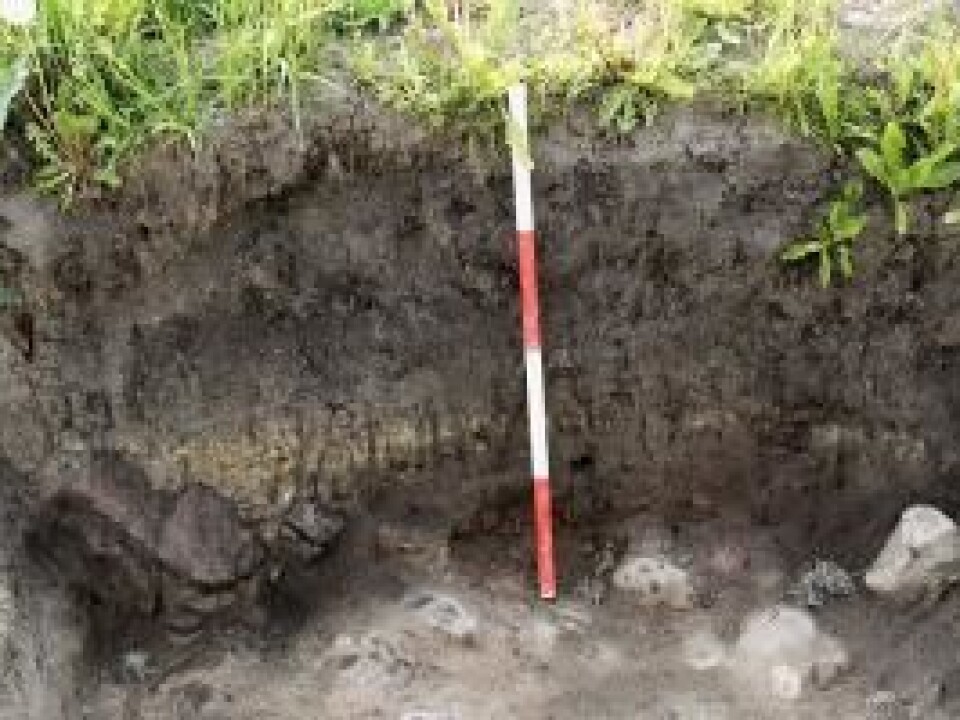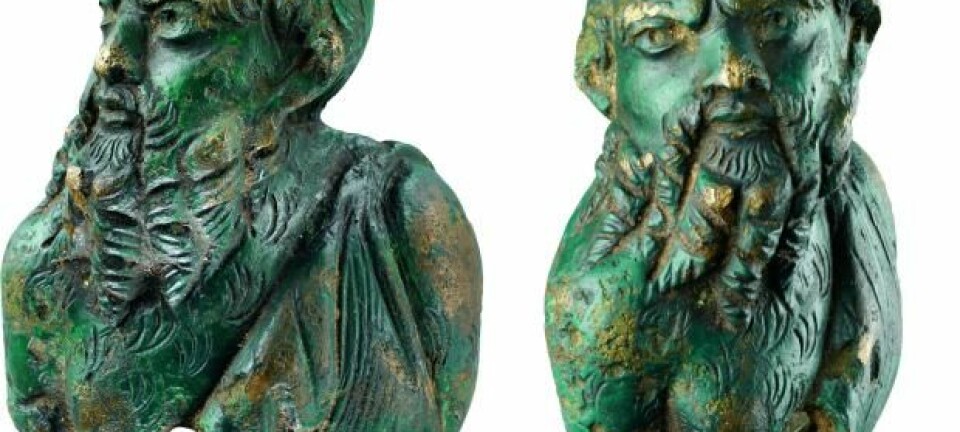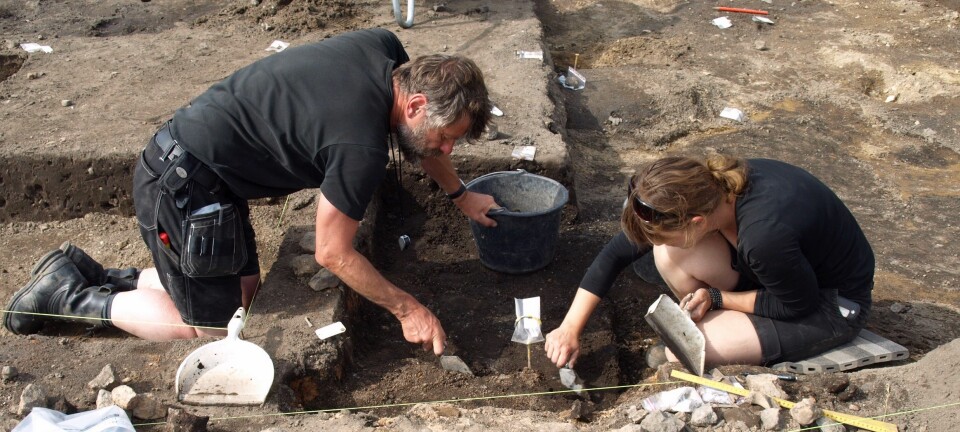
Ancient Roman artifact found on Danish island
A rare bronze brooch excavated on the Danish island of Bornholm has left archaeologists mystified.
During the excavation of a Roman settlement on the island of Bornholm, Denmark, archeologists uncovered an astonishing find, an owl brooch made of bronze. Also known as a fibula, it is a highly decorated roman safety pin or a pin-brooch used for fastening garments. The brooch was cast as a flat piece of bronze and then decorated with enamel and glass disks in brilliant colours.
A defining feature is the bird’s big black glass pupils that seem to stare directly back at you. Its large luminous eyes are made even more dramatic by the stunning inlays of orange glass around the pupils.
The owl’s body is infilled with a green enamel, embedded with circular glass shapes in red, yellow, and black. The brooch also shows the bird’s feet and a tail decorated with indentations, in a very naturalistic representation of this proud animal.
The archaeologists were mystified and have immediately started to look for answers: where does this owl shaped piece of jewellery come from and how did it end up on Bornholm, an island in the middle of the Baltic Sea?
A long journey to Scandinavia

Between the 1st and 4th century AD, it was very common in the Roman world to produce flat brooches in a wide range of designs. These included common objects, such as axes, knives, or spears, and other items such as wheels, shoes, household pots, and musical instruments. The animal kingdom commonly inspired their designs, from the mythical (sea serpents) to the everyday (horses, dogs, bees, and various types of fish and birds). Many other animals such as deer, lions, leopards, boar, and dolphins, were also commonly depicted.
It is unusual however to find these kinds of enamelled brooches so far from provincial Roman territories, located north of present day Italy. They are especially concentrated at ancient forts along the northern border of the Roman Empire, along the Rhine and Danube rivers in what is now Germany, where soldiers stationed there would have used these ancient safety pins to secure their capes.
The frequent transfer of the Roman troops along the Empire's borders ensured the spread of these brooches and other possessions. In fact, significant amounts of bronze objects, glass cups, weapons (especially swords), and coins spread north to Germanic areas by the exchange of presents, trade, war, returning warriors, and as tribute payment to soldiers.
Roman ceramics and the more common brooch designs apparently had little interest north of the border, perhaps because the Germanic peoples produced their own fine quality jewelry according to their own fashions.

However, the more unique and colourful enamel brooches like this one, appear to have achieved some popularity.
The little owl was found in the Roman-age soil deposits being excavated, and located a few metres from the site of an ancient house at the site. Archaeologists do not yet know if the owners of this house also owned the brooch, but it is possible.
A special bird, both rare and symbolic
The owl design is unusual. It is one of the rarest types of animal depicted on enamel brooches of this era, and they are typically found in frontier forts, such as the famous Saalburg Roman fort near Frankfurt in Germany.
Smaller numbers are found in Belgium, France, Switzerland, Italy, Austria, Hungary, Bulgaria, South Russia, and even England, but they are nonetheless extremely rare in Northern Europe.
Most owl brooches date somewhere in the middle of the 1st to 3rd centuries AD.
The owl: a symbol of wisdom
Owls have a keen sense of night vision, enabling these highly skilled silent hunters to catch their prey unawares. This notion of owls as intelligent and wise animals is one that has endured throughout the ages as famous companions to both Athena, the Greek Goddess of war, and later to Minerva, the Roman goddess of wisdom, art, trade, and war.
In fact, Minerva was often depicted with an owl on her shoulder as a symbol of wisdom, making it a highly desirable animal for a Roman soldier.
We do not know if the Germanic perception of the owl was the same as the Romans, but many of them would have been mercenaries in the Roman territories and developed a deep insight into the Roman mentality and culture. It is likely that they also adopted Roman traditions of symbolic jewellery.
The brooch must have been something quite special at the time, both because of its unusual shape and bright colours. It must have given the wearer a great level of prestige.
Colours on the metal jewellery was rather unusual among the Germanic tribes in the Roman Iron Age.
Bornholm's many treasures
Bornholm, now an extremely popular vacation spot, has more Roman enamelled brooches than anywhere else in Scandinavia. About half a dozen have been found in recent years.
These brooches were not a commercial product, but brought back to the island by the Germanic soldiers serving in the Roman army.
In the Germanic area, these jewellery pieces are commonly found along the Elbe River - from the Roman border along the Rhine, right up to southern Jutland in Denmark. A route that many returning soldiers presumably followed and a significant area of contact between the Roman territories and the Baltic Sea, including Bornholm.
Larger excavation is underway, revealing an affluent Roman society
A larger excavation is now underway and the archaeologists hope to uncover many well-preserved remnants of this ancient community called Lavegaard.
Besides the owl brooch, the archaeologists have found pottery and ancient building materials, postholes marking the sites of ancient houses, along with architectural features such as ovens and hearths. All evidence of industry in the form of iron smelting or iron extraction and ceramics firing, and several well-preserved metal objects are also preserved, including a Viking aged bird brooch and coin.
An exciting discovery at the excavation was a major burial ground, possibly related to the Lavegaard settlement.
Once a grand site of standing stones, today only two remain. Many stones were likely removed within the last century.
The excavated area now totals more than 5000 m² and so is part of a much larger settlement, which in Roman times would have had direct access to the sea via an inlet, now a wetland located just south of the settlement.
In fact, all the evidence suggests that Lavegaard was a rather affluent society in its day. With easy access to the sea and evidence of industry and coins at the site, the inhabitants of Lavegaard could presumably afford to buy and produce valuable jewellery and other objects.
As far as the little owl brooch goes, we can only guess who the original owner was and how it came to be preserved on the island in the middle of the Baltic Sea. Perhaps it was lost or burned as part of a sacrifice. Maybe it was deliberately hidden for reasons known only to its owner. Most likely, we will never know the full story of the hidden remains of the Lavegaard society.
-------------
Read the original article in Danish on Videnskab.dk
Translated by: Catherine Jex









